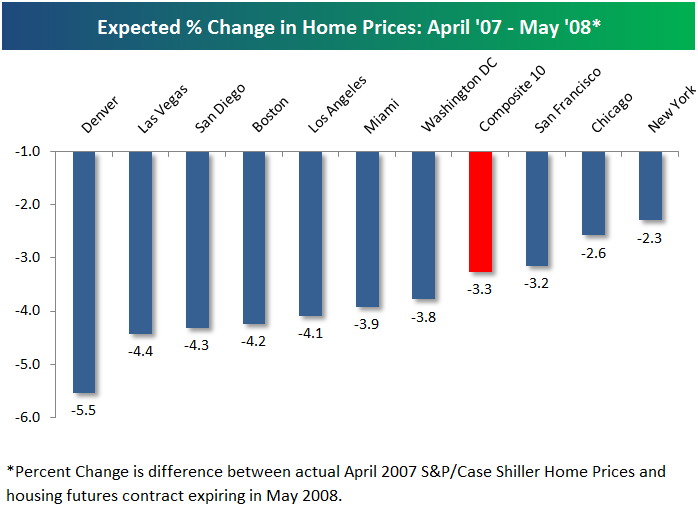Market for housing futures has yet to take off
Post on: 28 Июль, 2015 No Comment

Mar 23, 2012
John Dolan is a lonely guy. In 2010, he took on the role as an independent market maker for the S&P/Case-Shiller Home Price Index futures traded on the Chicago Mercantile Exchange. He is the only market maker in this sector.
(A market maker helps smooth out volatility on stock and commodity exchanges by standing ready to buy or sell particular stocks or commodities at publicly quoted prices.)
Whats more, Dolan can report for the last couple of years there has been very limited trading in the broad topic of home-price derivatives, which are based on the Case-Shiller Home Price Indices .
There was a flurry of trading when the product was introduced in 2006, he said. Unfortunately, futures trading started up about the absolute worst moment in time. Home prices went straight down afterward.
On his website, www.homepricefutures.com. Dolan tells readers: My original goal in setting up this site in 2010 was to foster discussion about the Case-Shiller futures that trade on the CME. My goal is to facilitate a better understanding by academics, regulators, policy makers, interested parties in housing transactions, rating agencies and traders in the market for home-price products.
OK, what is Dolan talking about here?
Futures are contracts where one tries to determine the value of a commodity, bond, currency or housing index at some point in the future. Futures are regulated by overseeing agencies and guaranteed by clearinghouses, and in order to insure that payment will occur, they have a margin requirement that must be settled daily. Hedgers often trade futures for the purpose of protecting against a price decline in assets they own.
Trading on an exchange reduces counterparty risk, makes price discovery easier and may allow a trader to more easily unwind a position that is an over-the-counter (OTC) housing derivative.
The obvious question that comes to mind: Why bother to trade futures on a derivative of real estate?
When you do a futures trade on any product, whether its gold, wheat or the stock market, you protect yourself against downside, Dolan said. A futures contract is a commitment to buy or sell an index at any point in time. Robert J. Shiller had the idea that much like foreign exchange and grain, people need a hedge against things they do in real estate, and he proposed these contracts.
Lets take for example, the 10-city Case-Shiller home-price index. which is a repeat-sale house-price index for 10 major metropolitan regions in the United States. One can bet, hedge, invest or speculate on where that index will be as far out as November 2016. So, if the index today is at 150 and you think the index in 2016 is going to be 180, you could buy the futures for the 2016 contract if its trading at 170. If you think home prices are going to stay very flat for the next five years, at 150 or lower, then you could sell the November 2016 contract at todays 170 price.
The question that nags: Why would one do any of this? Because investors and institutions that hold real estate might be concerned the value of their investments could possibly decline in the future. If thats the case, one can sell a futures contract to protect against the price going down.
Individuals might consider a futures contract, but there is a high bar in terms of having an understanding of the product, which means the future of Case-Shiller futures is probably with the institutional market.
And why should institutions be interested?
Institutions have long exposure to residential real estate so they should have the ability to hedge. And they should do it in a disciplined fashion, Dolan said. Also, a lot of investors buy distressed loan packages. If they could enter into a hedge against the market moving, they could lock in the specific value they create.

He added, People should be thinking of residential real estate as a component of an investment portfolio, along with, say, gold, commodities and stocks. Like other futures, this would give the investor the opportunity to gradually add or reduce the exposure to residential price movements in the portfolio.
I can see Dolans point, although its far beyond what most of us would consider even if we owned a small portfolio of residential houses.
The biggest problem with real estate, and even Dolan concedes this, is that sentiment tends to be either bullish or bearish. Over the last 15 years, housing prices shot straight up and then shot straight down. Whether, its gold or commodities or bonds, there has to be a debate or differences of opinion which way prices will go. Real estate futures have not lent themselves to that kind of trading.
So, why is Dolan in this space?
There was very little work that was done in terms of market expectations of home prices, Dolan said. I wanted to see if I could help frame the debate around where home prices are headed.
When Dolan started looking at Case-Shiller futures, contracts had virtually been abandoned. The market focused on other things; there (were) no orderly bid-ask spreads; (and there was) limited attention to the product, he said. I took it on as unpaid project. Thats the role I continue to have.
And, Dolan remains hopeful.
Real estate is typically the biggest asset in peoples portfolios, he said. As we have seen, prices can move dramatically. For those that continue to own but are concerned about price declines, hedging futures may make sense. For those looking to buy a house down the road, or who want to incrementally add exposure to a publicly priced benchmark real estate index, they can lock in forward home-price levels today.
Steve Bergsman is a freelance writer in Arizona and author of several books. His latest book, Growing Up Levittown : In a Time of Conformity, Controversy and Cultural Crisis , is now available for sale on Amazon.com .














